I feel the northeastern provinces are of particular relevance since ‘highland peoples’ are estimated to be in the majority in these provinces and thus pose a special challenge to both the current decentralization exercise and democracy. One benefit attributed to decentralization is the accommodation of local difference. This seems to be particularly challenging when a different language than the official one is involved, particularly given the rigid language provision in the Cambodian constitutional context. This poses severe challenges to decentralization and I don’t think it is well understood what ‘participation’, ‘civil society’, ‘capacity building’ and so on means in such linguistic and cultural circumstances. And I doubt that there are well established best practices. The rights of minority cultures are associated with very sensitive issues such as land rights, language rights, educational curriculum, regional autonomy, self government up to self-determination and most notorious secession which all are in one way or the other related to decentralization.
Continue reading Northeastern Provinces
Decentralization
I read a few introductory texts on decentralization and found very few references to cultural minorities with regard to Cambodia.
In an essay titled ‘Decentralization and Civil Society in Cambodia: a brave new state?’ I found very few references to my issue, among them the following one: “It should also be noted that the rights of minorities under the 1996 Cambodian nationality law are not explicit: Constitutional protection is extended only to ‘Khmer’ people, but it is not clear how this is to be defined in a multi-ethnic society. This point will be very relevant in gauging the democratic content of the decentralization exercise.”
In a Literature Review on Decentralization (2001) by CCSP I found few but helpful insights. About ethnic or religious minorities who live territorially concentrated the author notes “Such minorities often live in close proximity to and among majority groups, and when that is true, decentralization may actually empower arenas in which prejudices against minorities are stronger than at higher levels in the political system. It may suggest Manor (1997), make things worse.”
Continue reading Decentralization
???
This is dated January 2003 and for some reasons, I can not find this paper anymore in the internet. However, these documents (together with my suspicion of the World Bank and its fancy publications) seem to indicate that there may be reasons to question their assessment and to challenge their conclusions and associated decisions.
It might also be worth mentioning that many major players in the development field such as UN, World Bank, OECD, ILO and so on have adopted covenants conventions of minority rights.
Continue reading ???
World Bank – Operational Directive 4.2
It points out that RILGP must meet the requirements of Operational Directive 4.2, which is on Indigenous Peoples, itself a sensitive issue, and apparently demanding. The Bank determines that OD 4.2 applies with reference to “Highland Peoples” who maintain cultural and socioeconomic practices different than those practices by the Khmer national majority. The paper describes (tough) actions to be taken by the Royal Government of Cambodia to ensure that project arrangements meet the requirements of the directive in question.
Continue reading World Bank – Operational Directive 4.2
Highland Peoples Development Plan
This paper is titled “Additional Annex 14: Highland Peoples Development Plan. Cambodia: Rural Investment and Local Governance.” This paper starts “The World Bank is preparing a Rural Investment and Local Governance Project (RILGP) to support expansion of the Royal Government of Cambodia’s Seila Program”. It is stressed in this paper that at present, Seila objectives and procedures do not explicitly consider program impacts on the various ethnic minorities residing within program provinces.
Continue reading Highland Peoples Development Plan
Indigenous Peoples Plan
Of particular interest to my curiosity was a paper titled the Indigenous Peoples Plan (IP)-3/31/2003, which appears to be a document prepared by the Ministry of Public Works and Transport and Ministry of Rural Development and is titled Provincial and Rural Infrastructure Project (PRIP). Indigenous Peoples Development Framework (Draft)”. This paper appears to address the concerns expressed in a World Bank paper that I found in the internet when I was still in Germany.
Continue reading Indigenous Peoples Plan
World Bank – Provincial and Rural Infrastructure Project
On the world bank homepage I found that there is a ‘pipeline project’ called ‘Provincial and Rural Infrastructure Project’ associated with an IDA commitment of 20 USD$ million . Quite a bit of their project documentation is online available here.
Continue reading World Bank – Provincial and Rural Infrastructure Project
Another Publication
There is another important publication published by the Minority Rights Group on minorities in Cambodia. This is not available online, but can be bought online for 10 bucks. I assume I will find that in a local library soon. However, I expect this report to be less optimistic than the assessment by World Bank and ADB.
Continue reading Another Publication
International Labor Organization (ILO)
ILO has itself a policy on indigenous people and apparently provided training and regional exchange of ideas. The output of this support is a paper published under the title “Indigenous and Tribal Peoples Project, ILO and Inter-Ministerial Committee for Ethnic Minority Development in Cambodia. Final Report. National Workshop On Sharing Experience on Policy for Indigenous/Ethnic Minority Development in the Kingdom of Cambodia From 04-05 April 2002”
Continue reading International Labor Organization (ILO)
Fancy Publications – Asian Development Bank
With regard to cultural minorities in Cambodia, which I chose as subject of my internship, I found two fancy publications on the homepage of the Asian Development Bank, among them the following title of about 70 pages published by the Asian Development Bank: Indigenous Peoples/Ethnic Minorities and Poverty Reduction (June 2002), which turned out to be a regional report on Cambodia, Indonesia, Philippines, and Viet Nam and can be found here. According to the introduction, the ‘focal agency for the project’ was the ‘Inter-Ministerial Committee for highland Peoples Development (IMC), located in the Ministry of Rural Development’.
ADB published another book titled “Participatory Poverty Assessment in Cambodia (2001)” which can be downloaded here. It contains a chapter titled “Poverty among Ethnic Minorities“ which can be downloaded separately on the same page and provides good arguments for targeting indigenous people in the framework of poverty reduction strategies specifically. There seems to be various relationships between different kinds of cultural minorities and them being overrepresented among poor and extremely poor (impoverished) people. Both publications indicate that there has been a number of national (in Rattanakiri and Phnom Penh) and regional workshops. They claim that there has been local assessment with significant participation of all relevant stakeholders, including indigenous/ethnic minority representatives and local government officials.
Continue reading Fancy Publications – Asian Development Bank
Since my work is very exciting right now, I thought it would be a good idea to put down some report of more private nature. In contrast. However, this is closely related to what I am doing job wise.
Furthermore, I got the feeling that a lot of research needs and hopefully will be done on the issues that I would like to address but won’t be able to within the next three month. So I try to spread some ideas that might potentially be helpful for others down the road.
Continue reading
this is where I live
this is the entrance to the Amok guesthouse
This is where I live
This is very close to the guesthouse Amok in which I happen to live. Just follow this street and turn left before the four story building. to the left and not in the picture is the pagoda called wat lanka. this picture was taken yesterday in the early evening before it started to rain heavily.
The Killing Fields
Today is Sunday. I read that a local tourist company offers flights with hangliders or something like an ultra light airplane. I though this would be a nice way of exploring the city with a bird’s eye and so I initially planned to do so today. However, I called these folks and they told me it would not be possible today. But next weekend. So I decided to see the notorious ‘killing fields’, which are located about 15 kilometers outside Phnom Penh.
I decided to take the moto. After only about 2 kilometers the very urban surrounding of the center (where I life) faded. The rather small urban area appears to be surrounded be a (slim) belt of industrial plants and a likewise slim belt of urban slums. The landscape outside this very restricted urban (metropolitan?) region has a very rural touch to it and appears to be dominated by rice fields. I saw a few people, particularly women, laboring hard in the heat of the noon with very simple tools and instruments. Some children follow their cows along the street. Many children where playing under the roofs of simple shacks. Others where lying sluggishly in hammocks. Much of what happens in the private sphere back home happens here on the street and it is fascinating to observe the rather laid back activity of these rural folks.
The quality of the road and the bad shape of the shock absorbers made me feel the difference between urban and rural very direct. Whereas the urban area has a number of modern streets (used in a rather chaotic and seemingly inefficient way, I may be wrong), the part of the countryside I was passing does not. It is a very dusty type of an unpaved road with deep holes in it. It has not been raining the last three days and I wonder how this ‘road’ looks like after a heavy shiver of monsoon-like rain.
Despite their name, the killing fields appear to be a very peace- and beautiful place not only at the first glance.
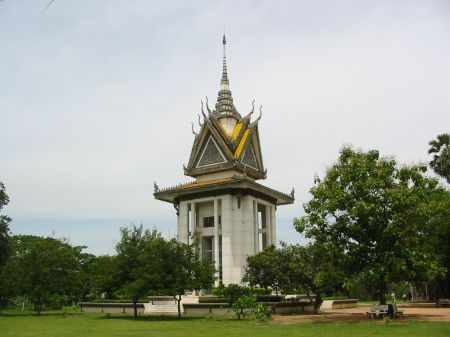
A tall tower with a colorful roof is located in the middle of a generous area covered with fertile vegetation and surrounded by rice fields. Some dogs sleep in the shadow of some bushes and some chickens scrape in the ground and cows graze close by. There are some holes in the grounds and signs tell that this hole and that hole is a mass grave. However, it is covered with grass and does not look too horrible.
There are many kids around who ask for money in a rather aggressive way. I gave some of them a reasonable amount, but constantly new kids emerged on the scene. Some of them, not older than 8, told me they would go only after I gave them 2 dollar. I felt very blackmailed and refused.
The group of children on the following photo was less militant. Maybe because the girls dominated this group. They asked for 100 Riel and I gave them 500, because they were five. However, they tried to persuade me that they are eight. But I insisted that they are five. I did not manage to convince the girl to the right, who is still doing calculations.
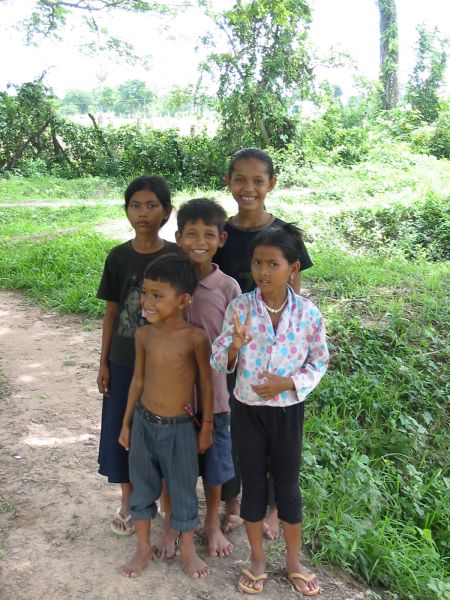
The content of this aesthetic tower offers a strong contrast to the surrounding peaceful scenery: carefully sorted along the age of the victims, thousands of sculls are presented in a monstrous cupboard which rises up to the roof of the building.
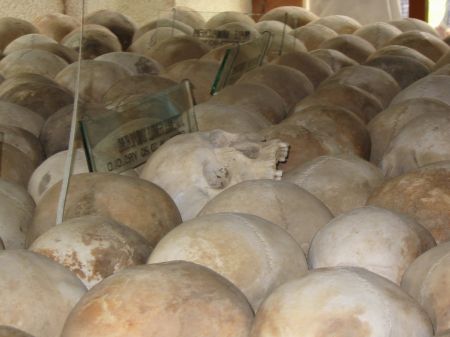
Tour guides stressed that these people where killed mostly with axes, sticks and swords, because the murders did not want to waste bullets.
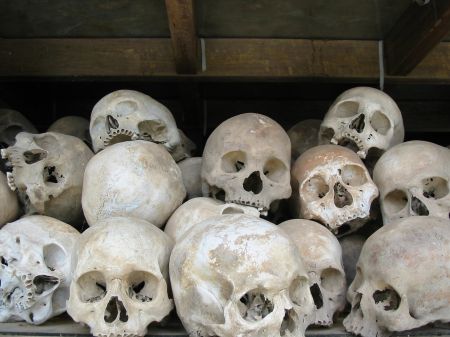
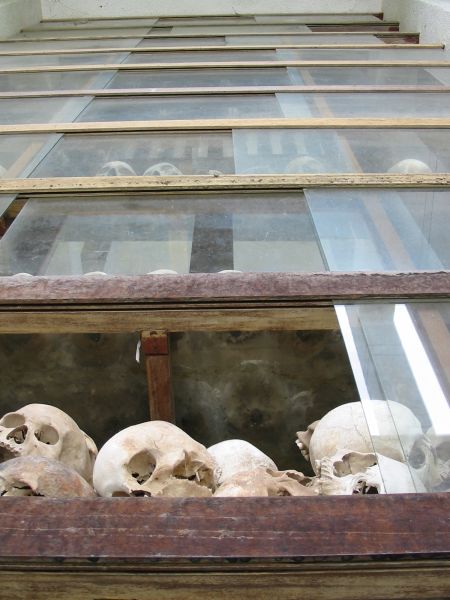
Although it was Sunday, the place really was not very busy. I thought this is really horrible and it would be a good act to bury this stuff to symbol some reconciliation with this bloody past.
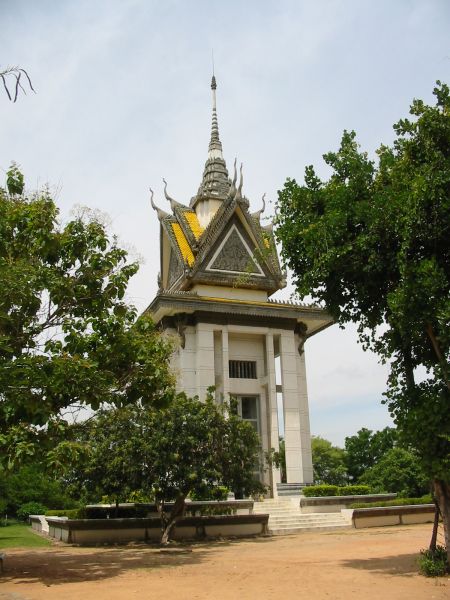
I spent about two hours and left again with the moto. I wanted to the Olympic Stadium, but surprisingly it was closed. So I went home and had some lunch at a restaurant in my street, which is run by Tamils from Sri Lanka. We engaged in a interesting discussion. One of them was has a French citizenship and his family lives in Germany. He was the first guy I met in this country who spoke fluently German. A Tamil from Sri Lanka who lives in Paris.
It was five when I left and I decided to read some literature, write some emails and these lines.
Continue reading The Killing Fields
Tuol-Sleng and the National Museum
Today is Saturday and decided to spend a touristy day. First of all, I slept until 10 am. Then, I went to a small restaurant in my street and had an extensive breakfast, while reading the newspaper.
Later, I went to the Tuol-Sleng-Museum. This really is a monument of Cambodia’s traumatic past.
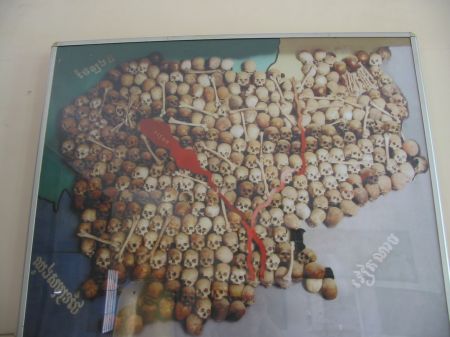
Under Pol Pot, a former school was turned into a concentration camp in which 20.000 children, women and man were imprisoned, tortured and executed dreadfully here between 1975 and 1979. There are about four buildings on the compound, each with numerous and unbelievably small cells.
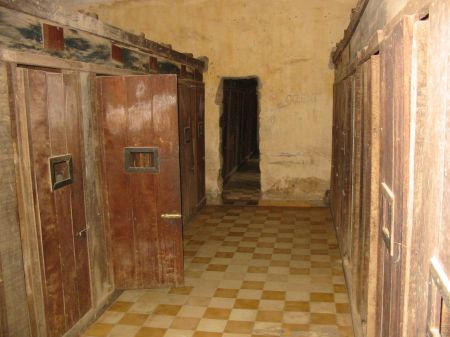
Prisoners were precisely registered and today one can look at countless photos of prisoners with the expression of horror in their eyes. Many of them children and women. The exhibition includes many of the original torture instruments and furnishings.
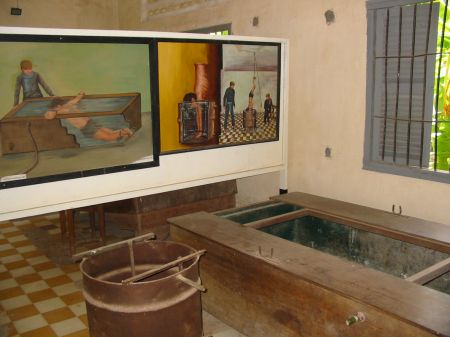
For me, this place was particularly touching because it seems to parallel German history.
I went back to my hotel and decided to visit the national museum, too. This time, I did not take the ‘moto’, but a ‘cyclo’. This is a really cool means of transportation. Provided one has enough time. Like a bicycle taxi. It is slow, but a good way of cruising the city, observing social interaction in the street and taking pictures.
A very attractive traditional building provides the space for the national museum. The base of the museum is quadrangular and encloses a beautiful inner courtyard. Exhibits are presented inside and outside the venerable high halls of the museum.
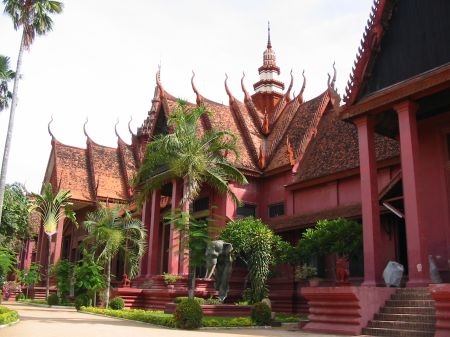
Many of the pieces date back to 400 BC and indicate extremely high levels of technical and craftsmanly sophistication. However, the number of motives is sort of limited. Every other exhibit is some kind of Buddha. After having seen the Tuol-Sleng-Museum before, I found it particularly strange how a people able of such high and complex civilization could fall into the kind of barbarism reflected in the exhibits of the Tuol-Sleng-Museum. Again, German history came to my mind. Although to my knowledge there was not much complexity or sophistication around 400 BC in Germany.
I met a young monk in the museum and we had a short conversation. His English was broken, but he kept smiling and I found him very sympathetic. Later, I sat down in the inner courtyard and had a cigarette. A guy from Japan was sitting there as well and we started a conversation. He was here to volunteer in an organization devoted to feed and teach children of poor families in Siam Reap. Later, the monk came to sit down as well and we managed to get a really cool multicultural dialogue (trialogue?) going. Also the Japanese guy’s English was kind of poor, but surprisingly (in the case of the monk, not the Japanese) both of them spoke Japanese. And the Japanese guy spoke some Khmer. Whenever we were not able to understand each other in English they were able to solve the problem in Japanese or Khmer. I found this to be a really interesting encounter and I am sure I will keep that in my mind for quite some time. And I am really thankful that I managed to take the following picture.
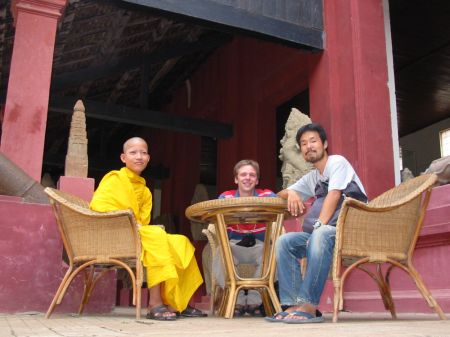
I went back to my guesthouse and had some rest. Later, I went with one of the employees to a cell phone shop to buy a … yes, a cell phone. Shelley advised me to do so because I won’t be accessible without it. Since there is no phone in the guesthouse and because I can access my email only on occasion. Cell phones are really popular around here and together with watches and motos the most important status symbols. Incidentally I hope this acquisition will enhance my social prestige significantly. Despite the fact that it is a second hand one.
Continue reading Tuol-Sleng and the National Museum

